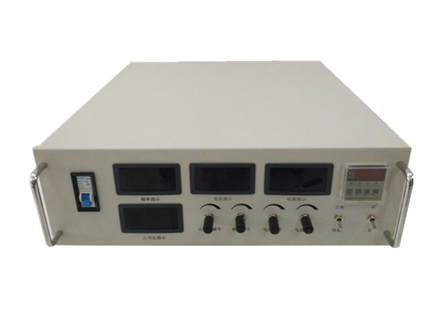Kaihong is a professional leader China Pulsed DC regulated power supply manufacturers with high quality and reasonable price.
I. Basic principle of periodic reversing pulse electroplating
Pulsed DC voltage regulated power supply. In the process of pulsed electroplating, when the current is switched on, the electrochemical polarization increases, metal ions near the cathode region are fully deposited, and the coating is fine and bright. When the current is turned off, the discharge ions near the cathode region return to the initial concentration, and the concentration polarization is eliminated.
Periodic reversing pulse electroplating habit is called double (that is, two-way) pulse electroplating, it is in the output of a group of forward pulse current after the introduction of a group of reverse pulse current, positive pulse duration is long reverse pulse duration is short, large, short time reverse pulse caused by the highly uneven anode current distribution will make the coating convex is strongly dissolved and flattened. The typical periodic reversing pulse waveform is shown below.
Two, the advantages of periodic reversing pulse plating
1, the reverse pulse current improves the thickness distribution of the coating, the coating thickness is uniform and the leveling property is good.
2, the anode dissolution of the reverse pulse makes the metal ion concentration on the cathode surface rise quickly, which is conducive to the use of high pulse current density in the subsequent cathode cycle, and the high pulse current density makes the formation rate of the crystal nucleus greater than the crystal growth rate, so the coating is dense, bright, low porosity.
3. The anode stripping of reverse pulse greatly reduces the attachment of organic impurities (including brightener) in the coating, so the coating has high purity and strong resistance to discoloration, which is especially prominent in cyanide silver plating.
4. The reverse pulse current oxidizes the hydrogen included in the coating, so that hydrogen embritzability can be eliminated (for example, the reverse pulse can remove the co-deposited hydrogen when electrodepositing palladium) or reduce the internal stress.
5, the periodic reverse pulse current makes the surface of the plating always in the activated state, so that good binding force coating can be obtained.
6, the reverse pulse is conducive to thinning the actual thickness of the diffusion layer and improving the cathode current efficiency, so the appropriate pulse parameters will further accelerate the deposition speed of the coating.
7. In the plating system where additives are not allowed or a small amount of additives are allowed, the double pulse plating can obtain fine, smooth and smooth coating.
Therefore, the coating temperature resistance, wear resistance, welding, toughness, anticorrosion, conductivity, resistance to discoloration, finish and other performance indicators are increased exponentially, and can greatly save precious metals (about 20%-50%), save additives (such as bright cyanide silver plating about 50%-80%).
Three, periodic reversing pulse current waveform
1. Single pulse reversal related to break time.
That is, a forward pulse with respect to break time is followed by a reverse pulse with respect to break time. This kind of waveform has the advantages of both pulse and reversing, but the disadvantage is that the reversing function of pulse is not perfect. Its waveform is shown below.
2. Single pulse reversal independent of break time.
In other words, a forward pulse with independent break time is followed by a reverse pulse with independent break time. This waveform can improve the thickness distribution of the coating significantly, but the effect of improving the crystallization of the coating is not ideal, so it is generally not suitable for precious metal plating. Its waveform is shown below.
3, pulse reversal
That is, a group of forward pulses is followed by a group of reverse pulses (note: both positive and reverse pulses are group waves rather than a single waveform). This waveform is a typical periodic reversing pulse waveform, which has the dual effect of improving the thickness distribution of the coating and improving the crystallization status of the coating. It is the most widely used in functional electroplating. Its waveform is shown below.
4, multiple pulse reversing
Referred to as multi-pulse, the programmable function is added on the basis of pulse reversing. The pulse parameters used in each program or period can be different. After adjusting the parameters of ordinary pulse reversing, it will not be changed until the end of the electroplating process. Its waveform is shown below.
Four, pulse DC regulated power supply uses:
Can be used for gold plating, silver, rare metal, nickel, zinc, tin, chromium and alloy, etc. Electroforming of copper and nickel; Application of electrolytic capacitor; Positive oxidation of aluminum, titanium and other products; Electrolytic polishing of precision parts; Battery charging, etc.
Five, the characteristics of pulse DC regulated power supply:
1, both pulse and reversing dual functions.
2. Positive and reverse pulse parameters can be adjusted separately.
3, at the same time can be used as two single pulse power supply.
4, can control the crystallization orientation of the coating.
5. Many output functions and parameters.
6, with peak current protection and operation fault protection function.

Hot Tags: Pulsed DC regulated power supply, China, Manufacturers, Suppliers, Factory, Customized, Brands, Price, Quotation, Quality, Durable

